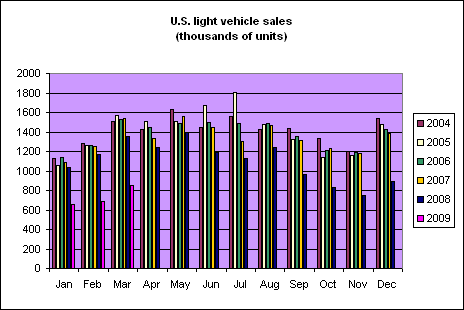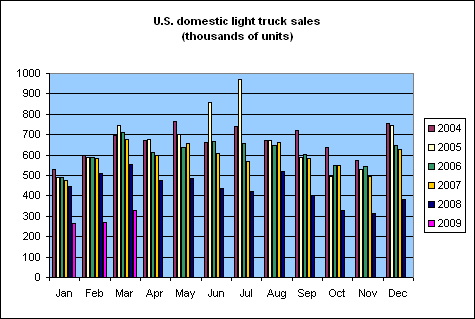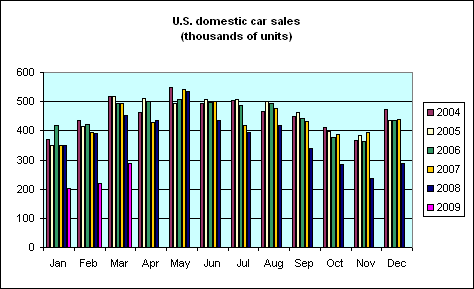Light vehicles sold in the U.S. last month were down 37% from March 2008, whereas February sales had been 41% below year-earlier values. Does a February-to-March increase and smaller year-over-year drop mean that we’ve turned the corner?
 |
I think not. Although Americans bought 168,000 more light vehicles in March than in February, the average February-to-March gain over the last five years has been 247,000 additional units. The main reason that the March ’08 to March ’09 comparison sounds like an improvement over February ’08 to February ’09 is that March ’08 was the beginning of the big downturn in auto sales. From that fact alone, we should continue to see improving year-over-year comparisons in subsequent months, particularly for domestically manufactured light trucks, the segment hit hardest by last spring and summer’s gasoline price spike.
 |
Detroit needs to sell more vehicles, not have smaller year-over-year drops, to remain viable.
 |
Nonetheless, the Wall Street Journal found some optimism to report:
“I believe we are in a bottoming process for the industry,” Bob Carter, a group vice president at Toyota Motor Corp., said in a conference call. Mr. Carter said the company’s 18% sales improvement in March compared with February could be “a very early indication that we have floored and some optimism is starting to return to the market.”
Michael DiGiovanni, the top sales analyst at General Motors Corp., said he expects a “very, very gradual pickup” in vehicle sales in the second quarter. He cited “the first signs of brightening” in the market. Jim Press, Chrysler LLC’s vice chairman and president, said, “The market is starting to show small signs of life which need to be nourished like seedlings”….
Positive signs also include rising used car prices, more cash buyers in the market and the expected return of the government and other large-scale vehicle buyers that will be boosting fleet sales, Ford officials said.
I’m certainly ready to cheer some good news when we get some. But I don’t see much basis for that in the March sales numbers.
Technorati Tags: macroeconomics,
autos,
auto sales,
economics,
recession
WSJ writes,
Positive signs also include rising used car prices, more cash buyers in the market and the expected return of the government and other large-scale vehicle buyers that will be boosting fleet sales, Ford officials said.
This is laughable. The Ford official is delusional. Everything he mentions as a positive sign if bad news for Ford. More used car sales mean fewer new car sales, more cash buyers means demand for lower priced vehicles, and relying on government purchases simply means more taxes to support the government sales and less productive resources.
Professor, you assessment is correct.
“The market is starting to show small signs of life which need to be nourished like seedlings”….
That guy watches too much CNBC, Kudlow. What the hell does “nourished like seedlings” mean?
Thanks for pointing out that the average Feb to March gain was larger over the last five years.
Another reason not to be optimistic is that sales incentives were up. According to the WSJ: “Auto makers offered, on average, a record $3,169 in incentives per vehicle sold in March, according to Web site Edmunds.com. The figure represents a jump of $733, or 30.1%, from a year earlier and $171, or 5.7%, from February.”
Also, fleet sales were up month over month. 30% of Chrysler sales were to fleets, which are less profitable.
“Detroit needs to sell more vehicles, not have smaller year-over-year drops, to remain viable.”
Or, Detroit could try to figure out how to be viable on smaller sales. Detroit may “need” to sell more cars; do we “need” to BUY more cars? I don’t know what it’s like where you live, but here (near Boston) there are more than enough cars already–the streets are choked with traffic, parking is difficult, used car lots are full. Yeah, sure, older cars will need to be replaced eventually, but we’re pretty well saturated with cars. Why should we want to increase the number of cars around here?
If you use he SAAR data it shows a big jump from
February to March.
One month does not a trend make, but it is so much easier to see what is happening and compare it with all the other data that is SAAR.
This ties in with the January retail sales data to show that real PCE is trying to bottom, but the bottoming process is extremely fragile.
In essence we are now looking at first quarter real PCE growth (Q/Q) of some 1% plus in the first quarter. this is a very sharp contrast to the fourth quarter when the drop in real PCE accounted for about half of the 6.3% drop in real GDP.
Jan-2008 15.3691
Feb-2008 15.3564
Mar-2008 15.1022
Apr-2008 14.5214
May-2008 14.2591
Jun-2008 13.6856
Jul-2008 12.5518
Aug-2008 13.7164
Sep-2008 12.4982
Oct-2008 10.5567
Nov-2008 10.1754
Dec-2008 10.3067
Jan-09 9.5700
Feb-09 9.1225
Mar-09 9.8600
P.S. My local Ford dealer, much more trucks than cars is advertising for sales help.
Here is how to find the BEA SAAR data, but they have yet to publish the March data.
(3) Instructions for access to BEA data:
1. Go to BEA’s website: http://www.bea.gov;
2. Click on ‘Gross Domestic Product’ (under the National section)
3. Scroll down to the bottom of the page to ‘Supplemental estimates’
4 Click on ‘Underlying detail tables’ (1st item)
5. Click on ‘List of Underlying Detail Tables’
6. Click on ‘7 – Motor vehicle output’
7. Click on ‘Table 7.2.5S’
8. Scroll down to line 37 which begins the average expenditure per car section.
Trying to make the ~700k job losses (and growing) stay in that picture of increasing PCE…more time to shop?
And since it isn’t that big ticket item, the auto/truck, it feels like spare change?
We was all so nervous before, but now that we’ve seen Lil Ben on ’60 Min’, it’s time to bust out?
I don’t know, spencer, encouraging maybe…but sustainable?
Is it possible that high end consumers might account for this little bounce (did Porsche sales mirror this as opposed to F150s)? How long can a few perform the consumption of many?
I remain skeptical.
We have stopped falling, but we have not started rising. The two are not always at the same instant.
It is that simple.
“More used car sales mean fewer new car sales”
Nonsense. The number of used cars “out there” is constant (no-one manufactures used cars). If someone buys a used car then someone else sold their car and now needs another car…
John Smith exhibits the typically blinkered thinking of many corporate economists: that people need to replace their cars at historic rates when those vehicles wear out. They do not. Many families are reducing the numbers of vehicles they own. This trend will accelerate when they expense out the true annual cost of owning a vehicle, which is more than $8,000 per year.
John Smith,
No John. There are government sales of used cars from their fleet, there are the sales of rental cars and of leased cars by the dealers. All of these sales are up while new car sales are down primarily because the need for leased cars and rental cars has declined. Statistics also show that the average length of time someone keeps a car before buying a new one has increased. His logic is faulty.
Are “regular” people getting paid more? If they aren’t then everything else is at best temporary and probably just noise in the data.
Manufactured goods do wear out when they, not you, want them too so people cannot just stop. For example, I would guess that PCE numbers aren’t noise, but are a reflection of just everybody putting off replacing things for too long.
Here is what I saw last weekend here in Texas at local dealerships while shopping for my soon-to- be HS grad (1) the used dept was very busy, while at the same time selection was very limited, some lots half empty! (2) only a few browsers in the new lots. A visit to the new showroom and you were pounced on by multiple salespersons.
Something’s gotta give..
The weather in February 2007 might have been much better than normal, hence higher than normal sales, hence a greater *drop* for February 2008. Then if March goes back to normal weather, it looks like an improvement, all else equal.
how fast did car sales turn around in the 1920-21 depression?
Interesting that in the data detail over the last few months that subcompacts, compacts and hybrids in general have fared much better than say, full sized pickup trucks and SUVs. It’s too bad that Detroit doesn’t know how to make desirable fuel efficient vehicles, how to market them or how to make money on them.
Zero S, anyone?
In Europe and UK, there is cash available to trade in old gas guzzlers (10 years old) and buy a new car. Stimulates the economy and buy a more energy efficient car.
Also talk of loans to build “green cars”.